Audit Report: Analyzing Key Audit Matters and ASA 701 Compliance
VerifiedAdded on 2020/05/28
|17
|4011
|216
Report
AI Summary
This report examines the application of ASA 701, focusing on the communication of key audit matters in independent auditor's reports. It analyzes two case studies: Advanced Computer Solutions Limited (inventory) and Green Machine Limited (property, plant, and equipment). The report assesses risks of material misstatement, identifies key audit assertions (occurrence, completeness, accuracy, authorization, and cutoff), and details substantive audit procedures. It explores the requirements of ASA 701, determines key audit matters for each case, and outlines necessary disclosures in the Key Audit Matters section of the auditor's report. The analysis includes discussions on inventory turnover, sales discrepancies, and the valuation of assets, emphasizing the importance of internal controls and accurate financial reporting. The report concludes by highlighting the significance of ASA 701 in enhancing transparency and the communicative value of audit reports, providing valuable insights for students and professionals in the field of auditing.
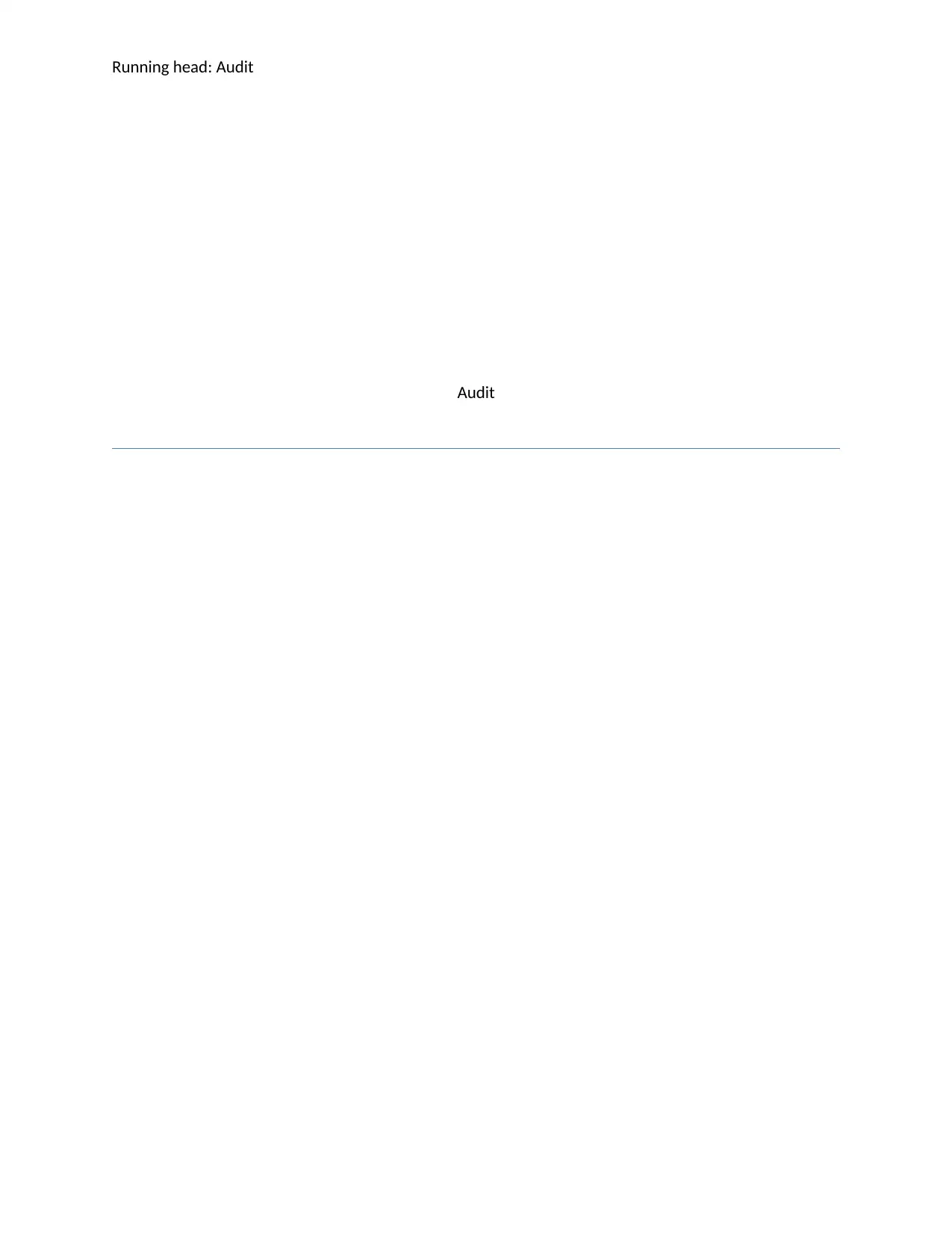
Running head: Audit
Audit
Audit
Paraphrase This Document
Need a fresh take? Get an instant paraphrase of this document with our AI Paraphraser
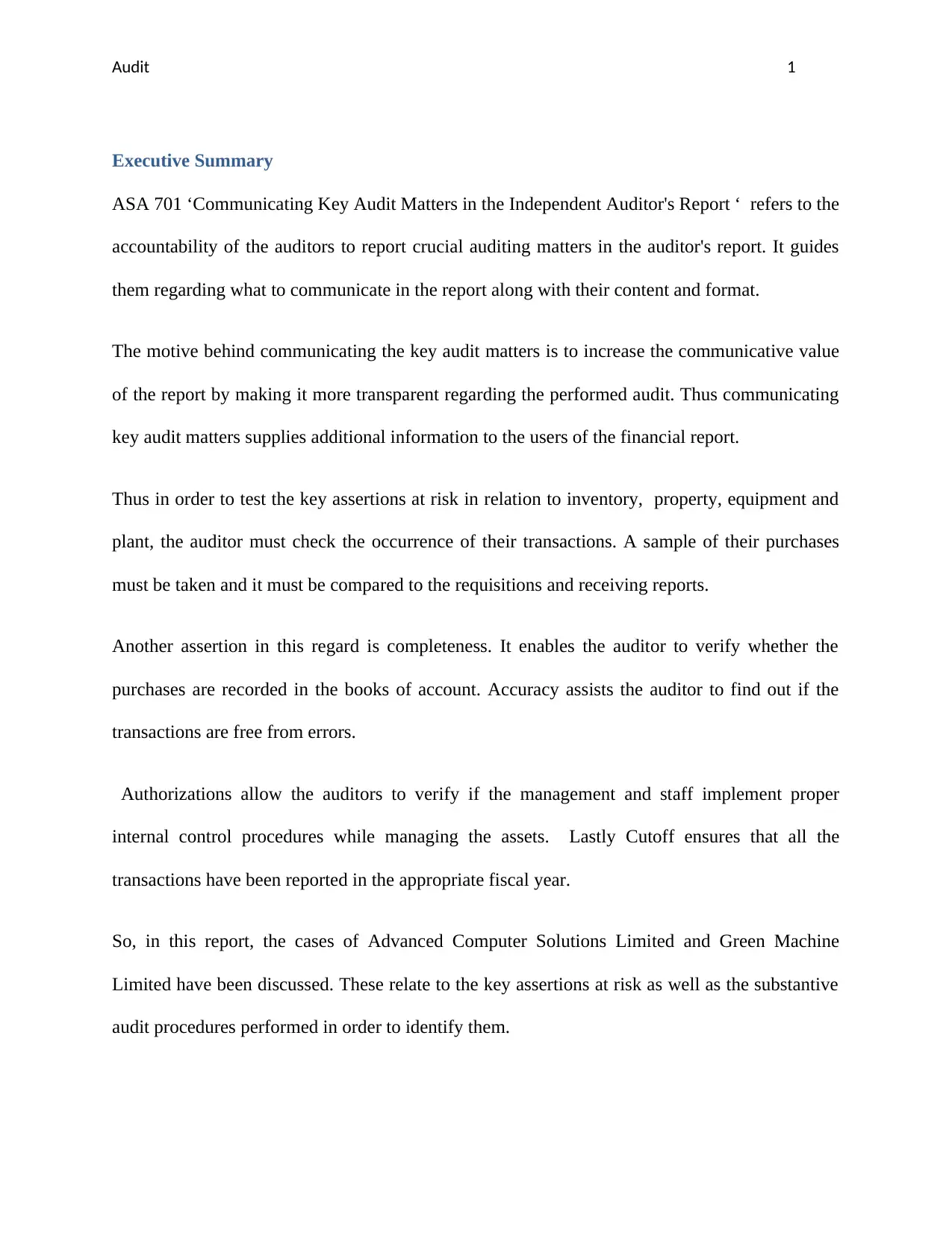
Audit 1
Executive Summary
ASA 701 ‘Communicating Key Audit Matters in the Independent Auditor's Report ‘ refers to the
accountability of the auditors to report crucial auditing matters in the auditor's report. It guides
them regarding what to communicate in the report along with their content and format.
The motive behind communicating the key audit matters is to increase the communicative value
of the report by making it more transparent regarding the performed audit. Thus communicating
key audit matters supplies additional information to the users of the financial report.
Thus in order to test the key assertions at risk in relation to inventory, property, equipment and
plant, the auditor must check the occurrence of their transactions. A sample of their purchases
must be taken and it must be compared to the requisitions and receiving reports.
Another assertion in this regard is completeness. It enables the auditor to verify whether the
purchases are recorded in the books of account. Accuracy assists the auditor to find out if the
transactions are free from errors.
Authorizations allow the auditors to verify if the management and staff implement proper
internal control procedures while managing the assets. Lastly Cutoff ensures that all the
transactions have been reported in the appropriate fiscal year.
So, in this report, the cases of Advanced Computer Solutions Limited and Green Machine
Limited have been discussed. These relate to the key assertions at risk as well as the substantive
audit procedures performed in order to identify them.
Executive Summary
ASA 701 ‘Communicating Key Audit Matters in the Independent Auditor's Report ‘ refers to the
accountability of the auditors to report crucial auditing matters in the auditor's report. It guides
them regarding what to communicate in the report along with their content and format.
The motive behind communicating the key audit matters is to increase the communicative value
of the report by making it more transparent regarding the performed audit. Thus communicating
key audit matters supplies additional information to the users of the financial report.
Thus in order to test the key assertions at risk in relation to inventory, property, equipment and
plant, the auditor must check the occurrence of their transactions. A sample of their purchases
must be taken and it must be compared to the requisitions and receiving reports.
Another assertion in this regard is completeness. It enables the auditor to verify whether the
purchases are recorded in the books of account. Accuracy assists the auditor to find out if the
transactions are free from errors.
Authorizations allow the auditors to verify if the management and staff implement proper
internal control procedures while managing the assets. Lastly Cutoff ensures that all the
transactions have been reported in the appropriate fiscal year.
So, in this report, the cases of Advanced Computer Solutions Limited and Green Machine
Limited have been discussed. These relate to the key assertions at risk as well as the substantive
audit procedures performed in order to identify them.
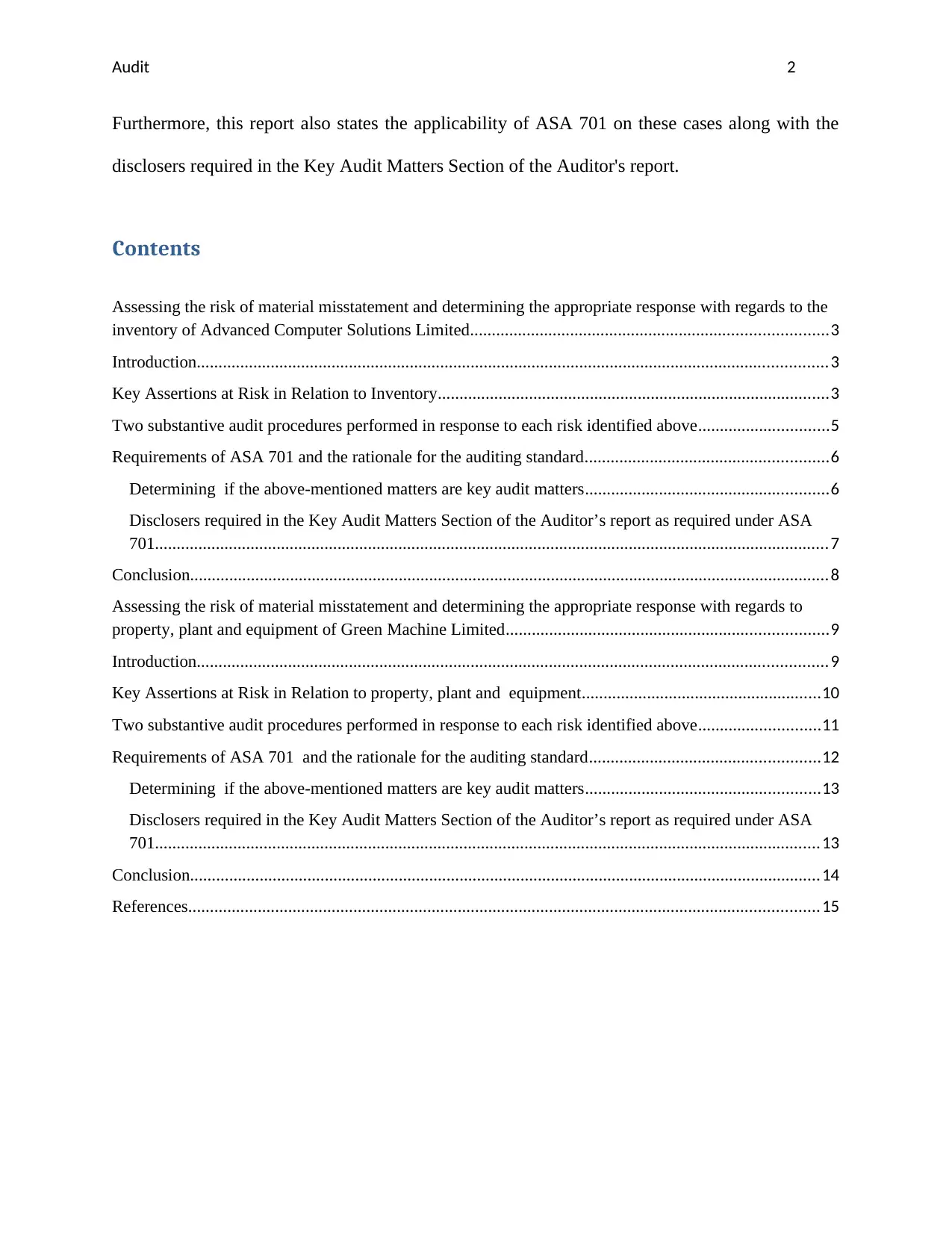
Audit 2
Furthermore, this report also states the applicability of ASA 701 on these cases along with the
disclosers required in the Key Audit Matters Section of the Auditor's report.
Contents
Assessing the risk of material misstatement and determining the appropriate response with regards to the
inventory of Advanced Computer Solutions Limited..................................................................................3
Introduction.................................................................................................................................................3
Key Assertions at Risk in Relation to Inventory..........................................................................................3
Two substantive audit procedures performed in response to each risk identified above..............................5
Requirements of ASA 701 and the rationale for the auditing standard........................................................6
Determining if the above-mentioned matters are key audit matters........................................................6
Disclosers required in the Key Audit Matters Section of the Auditor’s report as required under ASA
701...........................................................................................................................................................7
Conclusion...................................................................................................................................................8
Assessing the risk of material misstatement and determining the appropriate response with regards to
property, plant and equipment of Green Machine Limited..........................................................................9
Introduction.................................................................................................................................................9
Key Assertions at Risk in Relation to property, plant and equipment.......................................................10
Two substantive audit procedures performed in response to each risk identified above............................11
Requirements of ASA 701 and the rationale for the auditing standard.....................................................12
Determining if the above-mentioned matters are key audit matters......................................................13
Disclosers required in the Key Audit Matters Section of the Auditor’s report as required under ASA
701.........................................................................................................................................................13
Conclusion.................................................................................................................................................14
References.................................................................................................................................................15
Furthermore, this report also states the applicability of ASA 701 on these cases along with the
disclosers required in the Key Audit Matters Section of the Auditor's report.
Contents
Assessing the risk of material misstatement and determining the appropriate response with regards to the
inventory of Advanced Computer Solutions Limited..................................................................................3
Introduction.................................................................................................................................................3
Key Assertions at Risk in Relation to Inventory..........................................................................................3
Two substantive audit procedures performed in response to each risk identified above..............................5
Requirements of ASA 701 and the rationale for the auditing standard........................................................6
Determining if the above-mentioned matters are key audit matters........................................................6
Disclosers required in the Key Audit Matters Section of the Auditor’s report as required under ASA
701...........................................................................................................................................................7
Conclusion...................................................................................................................................................8
Assessing the risk of material misstatement and determining the appropriate response with regards to
property, plant and equipment of Green Machine Limited..........................................................................9
Introduction.................................................................................................................................................9
Key Assertions at Risk in Relation to property, plant and equipment.......................................................10
Two substantive audit procedures performed in response to each risk identified above............................11
Requirements of ASA 701 and the rationale for the auditing standard.....................................................12
Determining if the above-mentioned matters are key audit matters......................................................13
Disclosers required in the Key Audit Matters Section of the Auditor’s report as required under ASA
701.........................................................................................................................................................13
Conclusion.................................................................................................................................................14
References.................................................................................................................................................15
⊘ This is a preview!⊘
Do you want full access?
Subscribe today to unlock all pages.

Trusted by 1+ million students worldwide
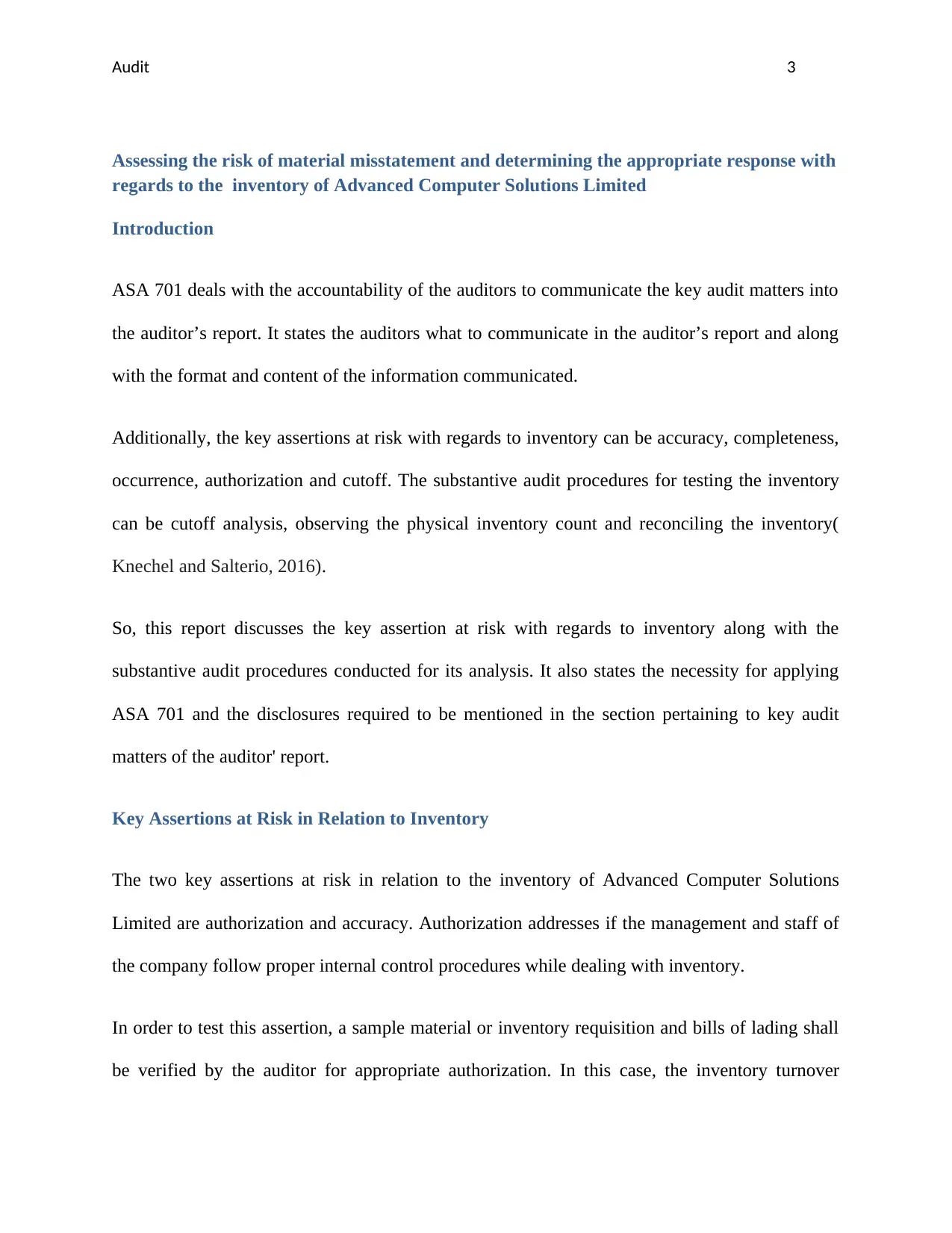
Audit 3
Assessing the risk of material misstatement and determining the appropriate response with
regards to the inventory of Advanced Computer Solutions Limited
Introduction
ASA 701 deals with the accountability of the auditors to communicate the key audit matters into
the auditor’s report. It states the auditors what to communicate in the auditor’s report and along
with the format and content of the information communicated.
Additionally, the key assertions at risk with regards to inventory can be accuracy, completeness,
occurrence, authorization and cutoff. The substantive audit procedures for testing the inventory
can be cutoff analysis, observing the physical inventory count and reconciling the inventory(
Knechel and Salterio, 2016).
So, this report discusses the key assertion at risk with regards to inventory along with the
substantive audit procedures conducted for its analysis. It also states the necessity for applying
ASA 701 and the disclosures required to be mentioned in the section pertaining to key audit
matters of the auditor' report.
Key Assertions at Risk in Relation to Inventory
The two key assertions at risk in relation to the inventory of Advanced Computer Solutions
Limited are authorization and accuracy. Authorization addresses if the management and staff of
the company follow proper internal control procedures while dealing with inventory.
In order to test this assertion, a sample material or inventory requisition and bills of lading shall
be verified by the auditor for appropriate authorization. In this case, the inventory turnover
Assessing the risk of material misstatement and determining the appropriate response with
regards to the inventory of Advanced Computer Solutions Limited
Introduction
ASA 701 deals with the accountability of the auditors to communicate the key audit matters into
the auditor’s report. It states the auditors what to communicate in the auditor’s report and along
with the format and content of the information communicated.
Additionally, the key assertions at risk with regards to inventory can be accuracy, completeness,
occurrence, authorization and cutoff. The substantive audit procedures for testing the inventory
can be cutoff analysis, observing the physical inventory count and reconciling the inventory(
Knechel and Salterio, 2016).
So, this report discusses the key assertion at risk with regards to inventory along with the
substantive audit procedures conducted for its analysis. It also states the necessity for applying
ASA 701 and the disclosures required to be mentioned in the section pertaining to key audit
matters of the auditor' report.
Key Assertions at Risk in Relation to Inventory
The two key assertions at risk in relation to the inventory of Advanced Computer Solutions
Limited are authorization and accuracy. Authorization addresses if the management and staff of
the company follow proper internal control procedures while dealing with inventory.
In order to test this assertion, a sample material or inventory requisition and bills of lading shall
be verified by the auditor for appropriate authorization. In this case, the inventory turnover
Paraphrase This Document
Need a fresh take? Get an instant paraphrase of this document with our AI Paraphraser
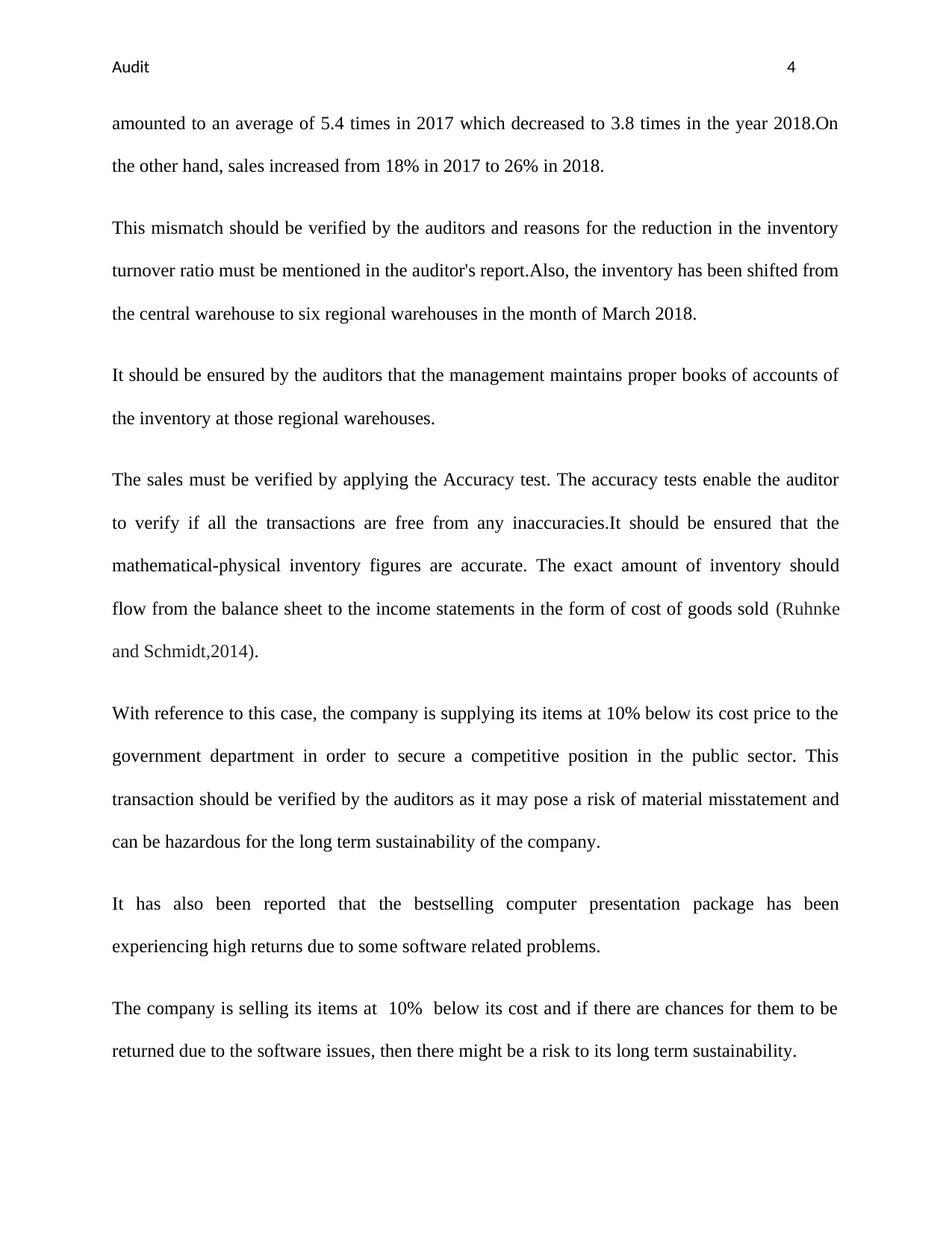
Audit 4
amounted to an average of 5.4 times in 2017 which decreased to 3.8 times in the year 2018.On
the other hand, sales increased from 18% in 2017 to 26% in 2018.
This mismatch should be verified by the auditors and reasons for the reduction in the inventory
turnover ratio must be mentioned in the auditor's report.Also, the inventory has been shifted from
the central warehouse to six regional warehouses in the month of March 2018.
It should be ensured by the auditors that the management maintains proper books of accounts of
the inventory at those regional warehouses.
The sales must be verified by applying the Accuracy test. The accuracy tests enable the auditor
to verify if all the transactions are free from any inaccuracies.It should be ensured that the
mathematical-physical inventory figures are accurate. The exact amount of inventory should
flow from the balance sheet to the income statements in the form of cost of goods sold (Ruhnke
and Schmidt,2014).
With reference to this case, the company is supplying its items at 10% below its cost price to the
government department in order to secure a competitive position in the public sector. This
transaction should be verified by the auditors as it may pose a risk of material misstatement and
can be hazardous for the long term sustainability of the company.
It has also been reported that the bestselling computer presentation package has been
experiencing high returns due to some software related problems.
The company is selling its items at 10% below its cost and if there are chances for them to be
returned due to the software issues, then there might be a risk to its long term sustainability.
amounted to an average of 5.4 times in 2017 which decreased to 3.8 times in the year 2018.On
the other hand, sales increased from 18% in 2017 to 26% in 2018.
This mismatch should be verified by the auditors and reasons for the reduction in the inventory
turnover ratio must be mentioned in the auditor's report.Also, the inventory has been shifted from
the central warehouse to six regional warehouses in the month of March 2018.
It should be ensured by the auditors that the management maintains proper books of accounts of
the inventory at those regional warehouses.
The sales must be verified by applying the Accuracy test. The accuracy tests enable the auditor
to verify if all the transactions are free from any inaccuracies.It should be ensured that the
mathematical-physical inventory figures are accurate. The exact amount of inventory should
flow from the balance sheet to the income statements in the form of cost of goods sold (Ruhnke
and Schmidt,2014).
With reference to this case, the company is supplying its items at 10% below its cost price to the
government department in order to secure a competitive position in the public sector. This
transaction should be verified by the auditors as it may pose a risk of material misstatement and
can be hazardous for the long term sustainability of the company.
It has also been reported that the bestselling computer presentation package has been
experiencing high returns due to some software related problems.
The company is selling its items at 10% below its cost and if there are chances for them to be
returned due to the software issues, then there might be a risk to its long term sustainability.
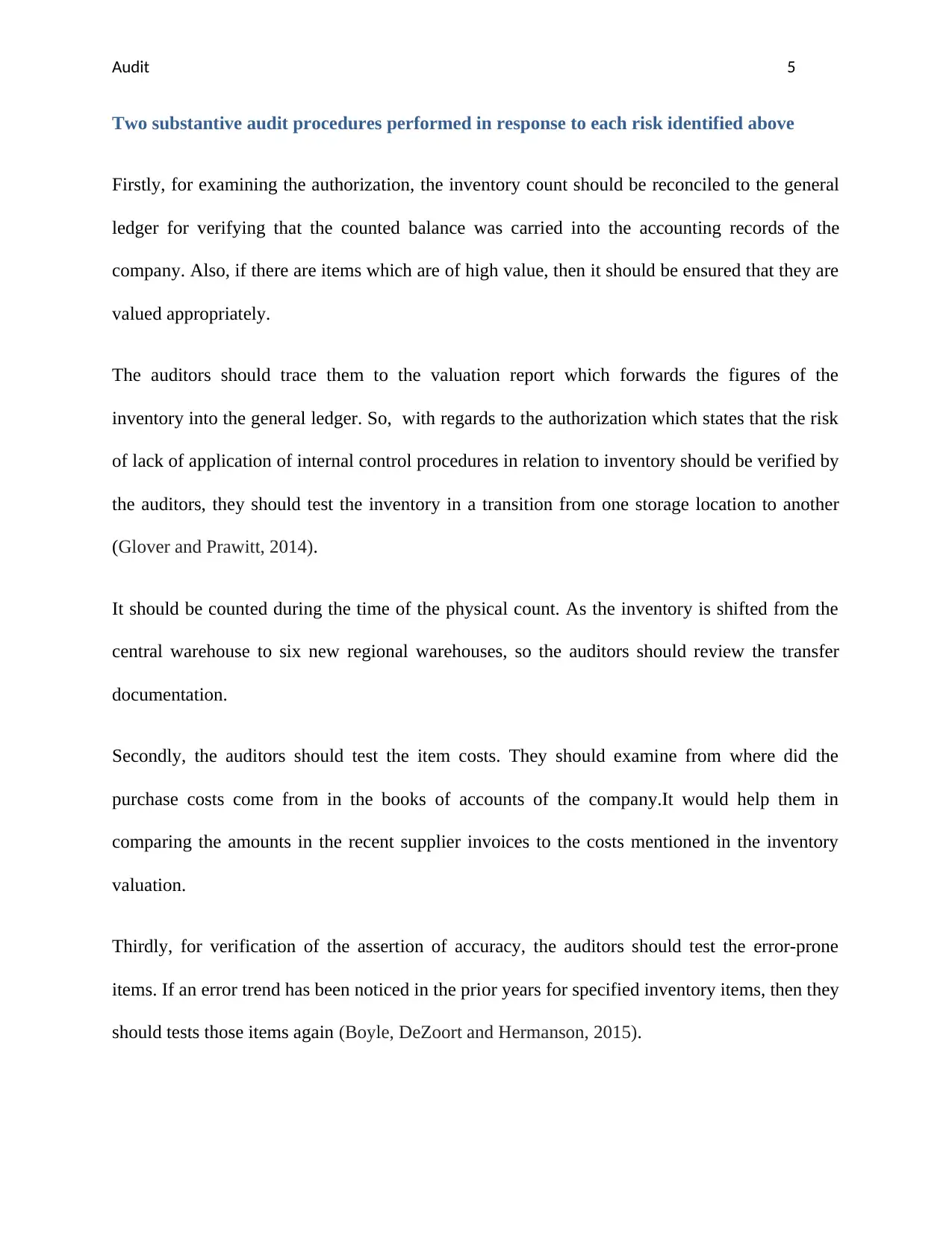
Audit 5
Two substantive audit procedures performed in response to each risk identified above
Firstly, for examining the authorization, the inventory count should be reconciled to the general
ledger for verifying that the counted balance was carried into the accounting records of the
company. Also, if there are items which are of high value, then it should be ensured that they are
valued appropriately.
The auditors should trace them to the valuation report which forwards the figures of the
inventory into the general ledger. So, with regards to the authorization which states that the risk
of lack of application of internal control procedures in relation to inventory should be verified by
the auditors, they should test the inventory in a transition from one storage location to another
(Glover and Prawitt, 2014).
It should be counted during the time of the physical count. As the inventory is shifted from the
central warehouse to six new regional warehouses, so the auditors should review the transfer
documentation.
Secondly, the auditors should test the item costs. They should examine from where did the
purchase costs come from in the books of accounts of the company.It would help them in
comparing the amounts in the recent supplier invoices to the costs mentioned in the inventory
valuation.
Thirdly, for verification of the assertion of accuracy, the auditors should test the error-prone
items. If an error trend has been noticed in the prior years for specified inventory items, then they
should tests those items again (Boyle, DeZoort and Hermanson, 2015).
Two substantive audit procedures performed in response to each risk identified above
Firstly, for examining the authorization, the inventory count should be reconciled to the general
ledger for verifying that the counted balance was carried into the accounting records of the
company. Also, if there are items which are of high value, then it should be ensured that they are
valued appropriately.
The auditors should trace them to the valuation report which forwards the figures of the
inventory into the general ledger. So, with regards to the authorization which states that the risk
of lack of application of internal control procedures in relation to inventory should be verified by
the auditors, they should test the inventory in a transition from one storage location to another
(Glover and Prawitt, 2014).
It should be counted during the time of the physical count. As the inventory is shifted from the
central warehouse to six new regional warehouses, so the auditors should review the transfer
documentation.
Secondly, the auditors should test the item costs. They should examine from where did the
purchase costs come from in the books of accounts of the company.It would help them in
comparing the amounts in the recent supplier invoices to the costs mentioned in the inventory
valuation.
Thirdly, for verification of the assertion of accuracy, the auditors should test the error-prone
items. If an error trend has been noticed in the prior years for specified inventory items, then they
should tests those items again (Boyle, DeZoort and Hermanson, 2015).
⊘ This is a preview!⊘
Do you want full access?
Subscribe today to unlock all pages.

Trusted by 1+ million students worldwide
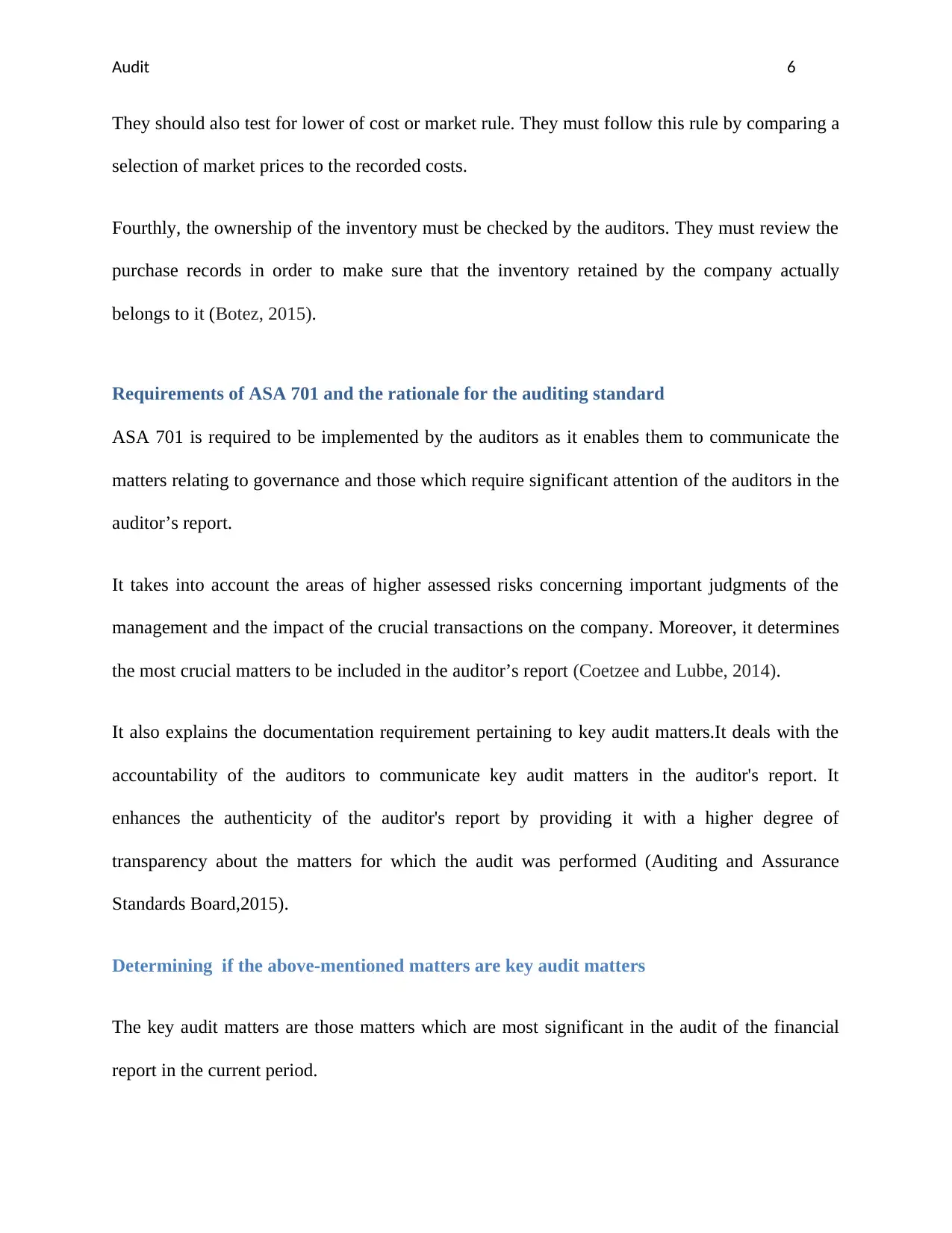
Audit 6
They should also test for lower of cost or market rule. They must follow this rule by comparing a
selection of market prices to the recorded costs.
Fourthly, the ownership of the inventory must be checked by the auditors. They must review the
purchase records in order to make sure that the inventory retained by the company actually
belongs to it (Botez, 2015).
Requirements of ASA 701 and the rationale for the auditing standard
ASA 701 is required to be implemented by the auditors as it enables them to communicate the
matters relating to governance and those which require significant attention of the auditors in the
auditor’s report.
It takes into account the areas of higher assessed risks concerning important judgments of the
management and the impact of the crucial transactions on the company. Moreover, it determines
the most crucial matters to be included in the auditor’s report (Coetzee and Lubbe, 2014).
It also explains the documentation requirement pertaining to key audit matters.It deals with the
accountability of the auditors to communicate key audit matters in the auditor's report. It
enhances the authenticity of the auditor's report by providing it with a higher degree of
transparency about the matters for which the audit was performed (Auditing and Assurance
Standards Board,2015).
Determining if the above-mentioned matters are key audit matters
The key audit matters are those matters which are most significant in the audit of the financial
report in the current period.
They should also test for lower of cost or market rule. They must follow this rule by comparing a
selection of market prices to the recorded costs.
Fourthly, the ownership of the inventory must be checked by the auditors. They must review the
purchase records in order to make sure that the inventory retained by the company actually
belongs to it (Botez, 2015).
Requirements of ASA 701 and the rationale for the auditing standard
ASA 701 is required to be implemented by the auditors as it enables them to communicate the
matters relating to governance and those which require significant attention of the auditors in the
auditor’s report.
It takes into account the areas of higher assessed risks concerning important judgments of the
management and the impact of the crucial transactions on the company. Moreover, it determines
the most crucial matters to be included in the auditor’s report (Coetzee and Lubbe, 2014).
It also explains the documentation requirement pertaining to key audit matters.It deals with the
accountability of the auditors to communicate key audit matters in the auditor's report. It
enhances the authenticity of the auditor's report by providing it with a higher degree of
transparency about the matters for which the audit was performed (Auditing and Assurance
Standards Board,2015).
Determining if the above-mentioned matters are key audit matters
The key audit matters are those matters which are most significant in the audit of the financial
report in the current period.
Paraphrase This Document
Need a fresh take? Get an instant paraphrase of this document with our AI Paraphraser
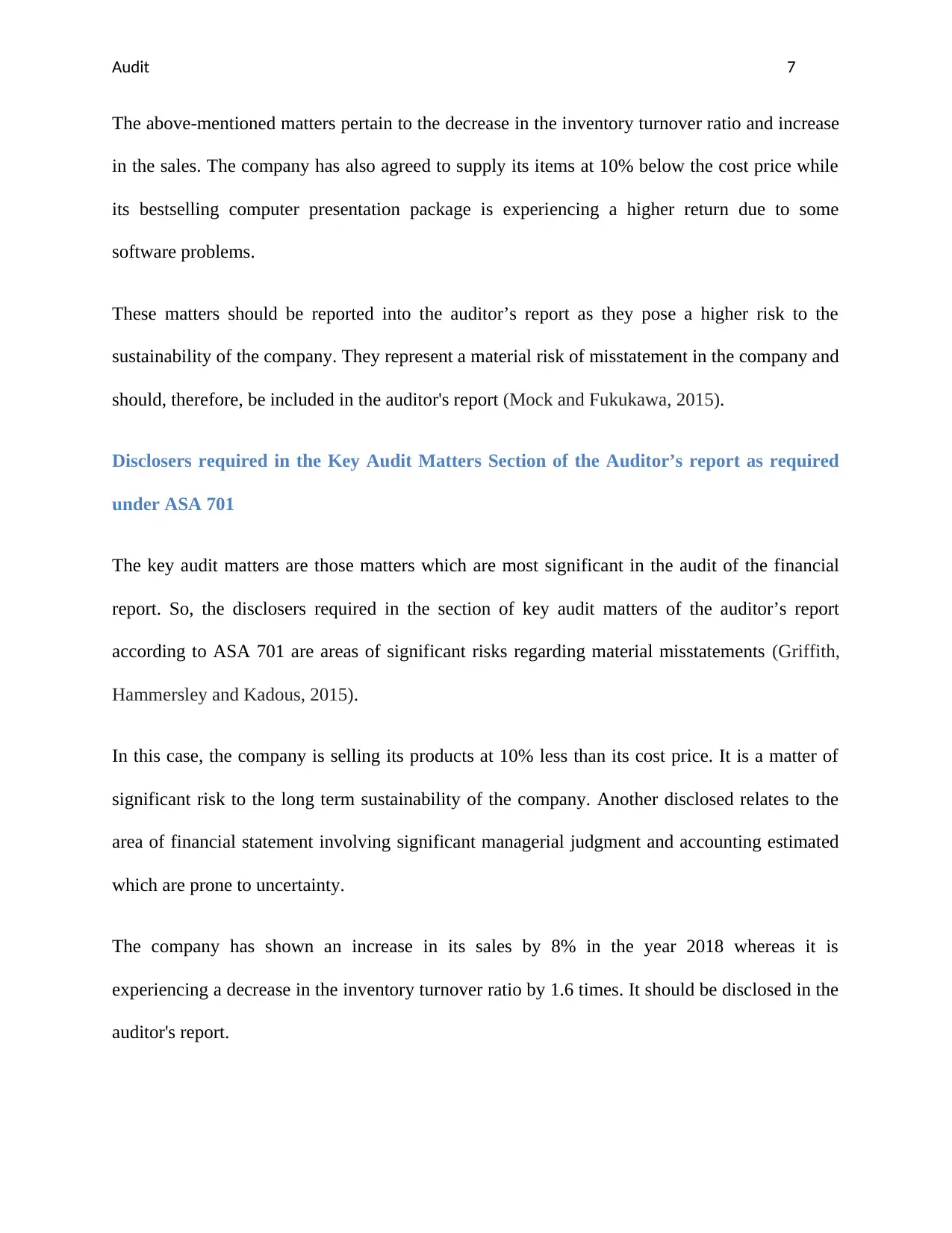
Audit 7
The above-mentioned matters pertain to the decrease in the inventory turnover ratio and increase
in the sales. The company has also agreed to supply its items at 10% below the cost price while
its bestselling computer presentation package is experiencing a higher return due to some
software problems.
These matters should be reported into the auditor’s report as they pose a higher risk to the
sustainability of the company. They represent a material risk of misstatement in the company and
should, therefore, be included in the auditor's report (Mock and Fukukawa, 2015).
Disclosers required in the Key Audit Matters Section of the Auditor’s report as required
under ASA 701
The key audit matters are those matters which are most significant in the audit of the financial
report. So, the disclosers required in the section of key audit matters of the auditor’s report
according to ASA 701 are areas of significant risks regarding material misstatements (Griffith,
Hammersley and Kadous, 2015).
In this case, the company is selling its products at 10% less than its cost price. It is a matter of
significant risk to the long term sustainability of the company. Another disclosed relates to the
area of financial statement involving significant managerial judgment and accounting estimated
which are prone to uncertainty.
The company has shown an increase in its sales by 8% in the year 2018 whereas it is
experiencing a decrease in the inventory turnover ratio by 1.6 times. It should be disclosed in the
auditor's report.
The above-mentioned matters pertain to the decrease in the inventory turnover ratio and increase
in the sales. The company has also agreed to supply its items at 10% below the cost price while
its bestselling computer presentation package is experiencing a higher return due to some
software problems.
These matters should be reported into the auditor’s report as they pose a higher risk to the
sustainability of the company. They represent a material risk of misstatement in the company and
should, therefore, be included in the auditor's report (Mock and Fukukawa, 2015).
Disclosers required in the Key Audit Matters Section of the Auditor’s report as required
under ASA 701
The key audit matters are those matters which are most significant in the audit of the financial
report. So, the disclosers required in the section of key audit matters of the auditor’s report
according to ASA 701 are areas of significant risks regarding material misstatements (Griffith,
Hammersley and Kadous, 2015).
In this case, the company is selling its products at 10% less than its cost price. It is a matter of
significant risk to the long term sustainability of the company. Another disclosed relates to the
area of financial statement involving significant managerial judgment and accounting estimated
which are prone to uncertainty.
The company has shown an increase in its sales by 8% in the year 2018 whereas it is
experiencing a decrease in the inventory turnover ratio by 1.6 times. It should be disclosed in the
auditor's report.
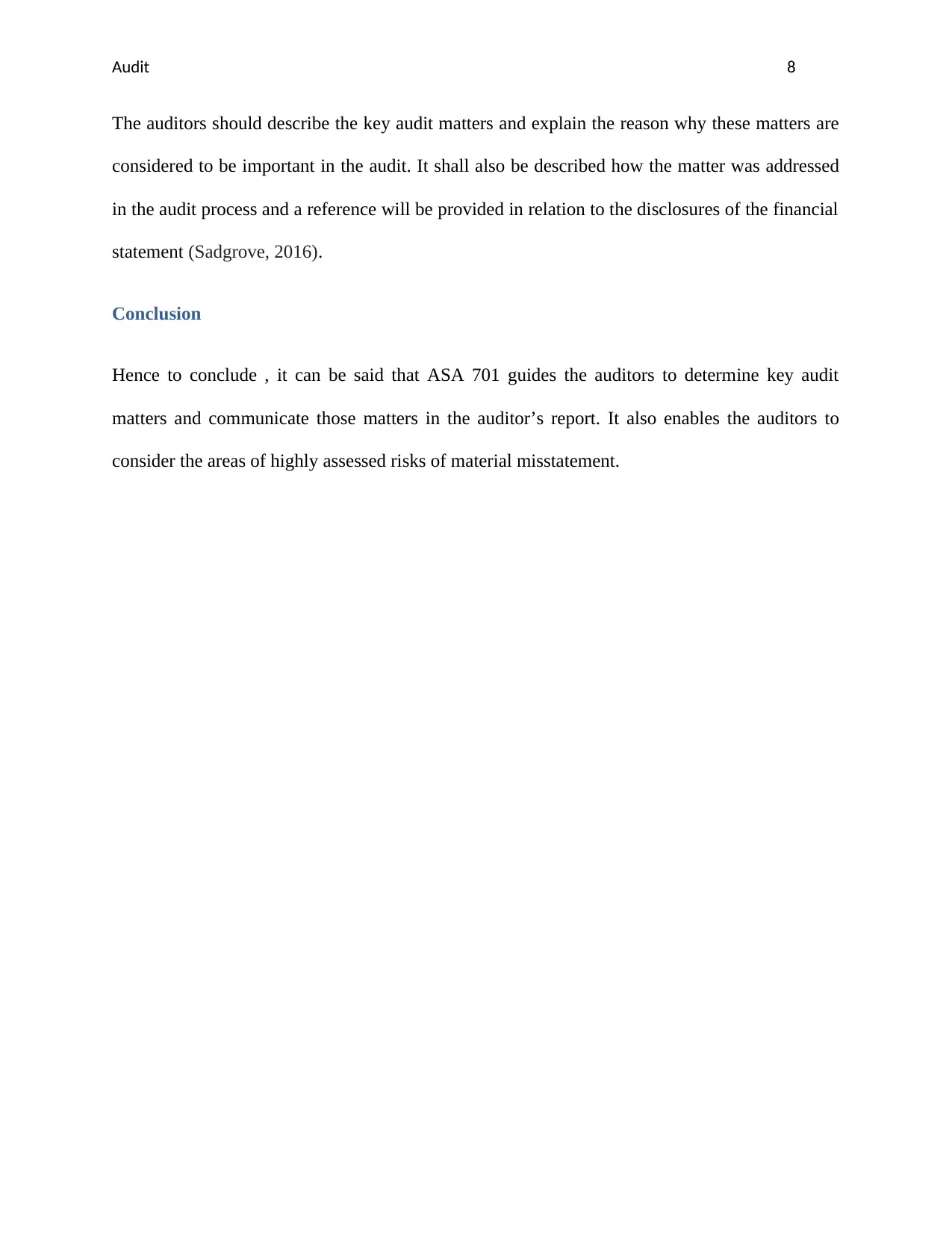
Audit 8
The auditors should describe the key audit matters and explain the reason why these matters are
considered to be important in the audit. It shall also be described how the matter was addressed
in the audit process and a reference will be provided in relation to the disclosures of the financial
statement (Sadgrove, 2016).
Conclusion
Hence to conclude , it can be said that ASA 701 guides the auditors to determine key audit
matters and communicate those matters in the auditor’s report. It also enables the auditors to
consider the areas of highly assessed risks of material misstatement.
The auditors should describe the key audit matters and explain the reason why these matters are
considered to be important in the audit. It shall also be described how the matter was addressed
in the audit process and a reference will be provided in relation to the disclosures of the financial
statement (Sadgrove, 2016).
Conclusion
Hence to conclude , it can be said that ASA 701 guides the auditors to determine key audit
matters and communicate those matters in the auditor’s report. It also enables the auditors to
consider the areas of highly assessed risks of material misstatement.
⊘ This is a preview!⊘
Do you want full access?
Subscribe today to unlock all pages.

Trusted by 1+ million students worldwide
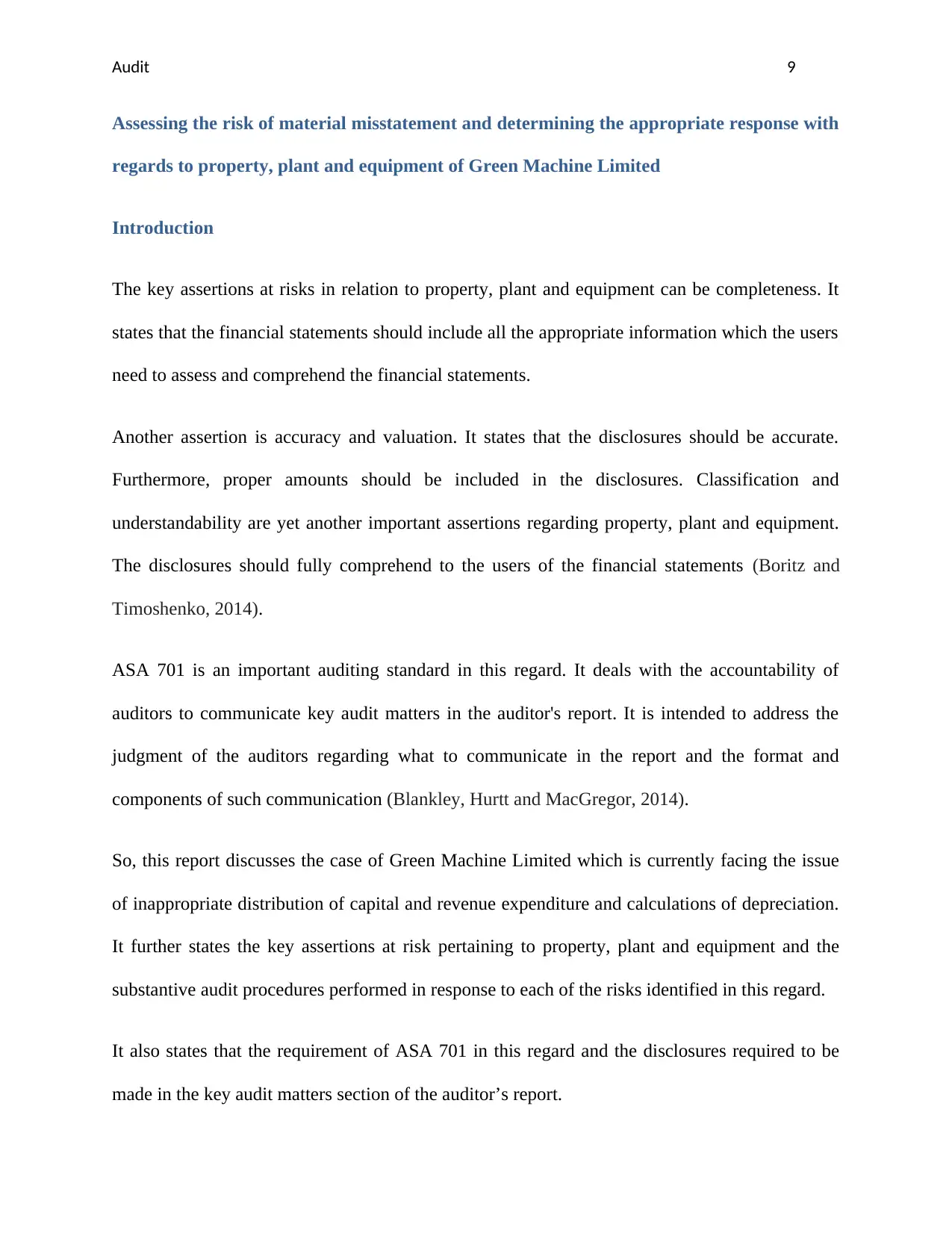
Audit 9
Assessing the risk of material misstatement and determining the appropriate response with
regards to property, plant and equipment of Green Machine Limited
Introduction
The key assertions at risks in relation to property, plant and equipment can be completeness. It
states that the financial statements should include all the appropriate information which the users
need to assess and comprehend the financial statements.
Another assertion is accuracy and valuation. It states that the disclosures should be accurate.
Furthermore, proper amounts should be included in the disclosures. Classification and
understandability are yet another important assertions regarding property, plant and equipment.
The disclosures should fully comprehend to the users of the financial statements (Boritz and
Timoshenko, 2014).
ASA 701 is an important auditing standard in this regard. It deals with the accountability of
auditors to communicate key audit matters in the auditor's report. It is intended to address the
judgment of the auditors regarding what to communicate in the report and the format and
components of such communication (Blankley, Hurtt and MacGregor, 2014).
So, this report discusses the case of Green Machine Limited which is currently facing the issue
of inappropriate distribution of capital and revenue expenditure and calculations of depreciation.
It further states the key assertions at risk pertaining to property, plant and equipment and the
substantive audit procedures performed in response to each of the risks identified in this regard.
It also states that the requirement of ASA 701 in this regard and the disclosures required to be
made in the key audit matters section of the auditor’s report.
Assessing the risk of material misstatement and determining the appropriate response with
regards to property, plant and equipment of Green Machine Limited
Introduction
The key assertions at risks in relation to property, plant and equipment can be completeness. It
states that the financial statements should include all the appropriate information which the users
need to assess and comprehend the financial statements.
Another assertion is accuracy and valuation. It states that the disclosures should be accurate.
Furthermore, proper amounts should be included in the disclosures. Classification and
understandability are yet another important assertions regarding property, plant and equipment.
The disclosures should fully comprehend to the users of the financial statements (Boritz and
Timoshenko, 2014).
ASA 701 is an important auditing standard in this regard. It deals with the accountability of
auditors to communicate key audit matters in the auditor's report. It is intended to address the
judgment of the auditors regarding what to communicate in the report and the format and
components of such communication (Blankley, Hurtt and MacGregor, 2014).
So, this report discusses the case of Green Machine Limited which is currently facing the issue
of inappropriate distribution of capital and revenue expenditure and calculations of depreciation.
It further states the key assertions at risk pertaining to property, plant and equipment and the
substantive audit procedures performed in response to each of the risks identified in this regard.
It also states that the requirement of ASA 701 in this regard and the disclosures required to be
made in the key audit matters section of the auditor’s report.
Paraphrase This Document
Need a fresh take? Get an instant paraphrase of this document with our AI Paraphraser
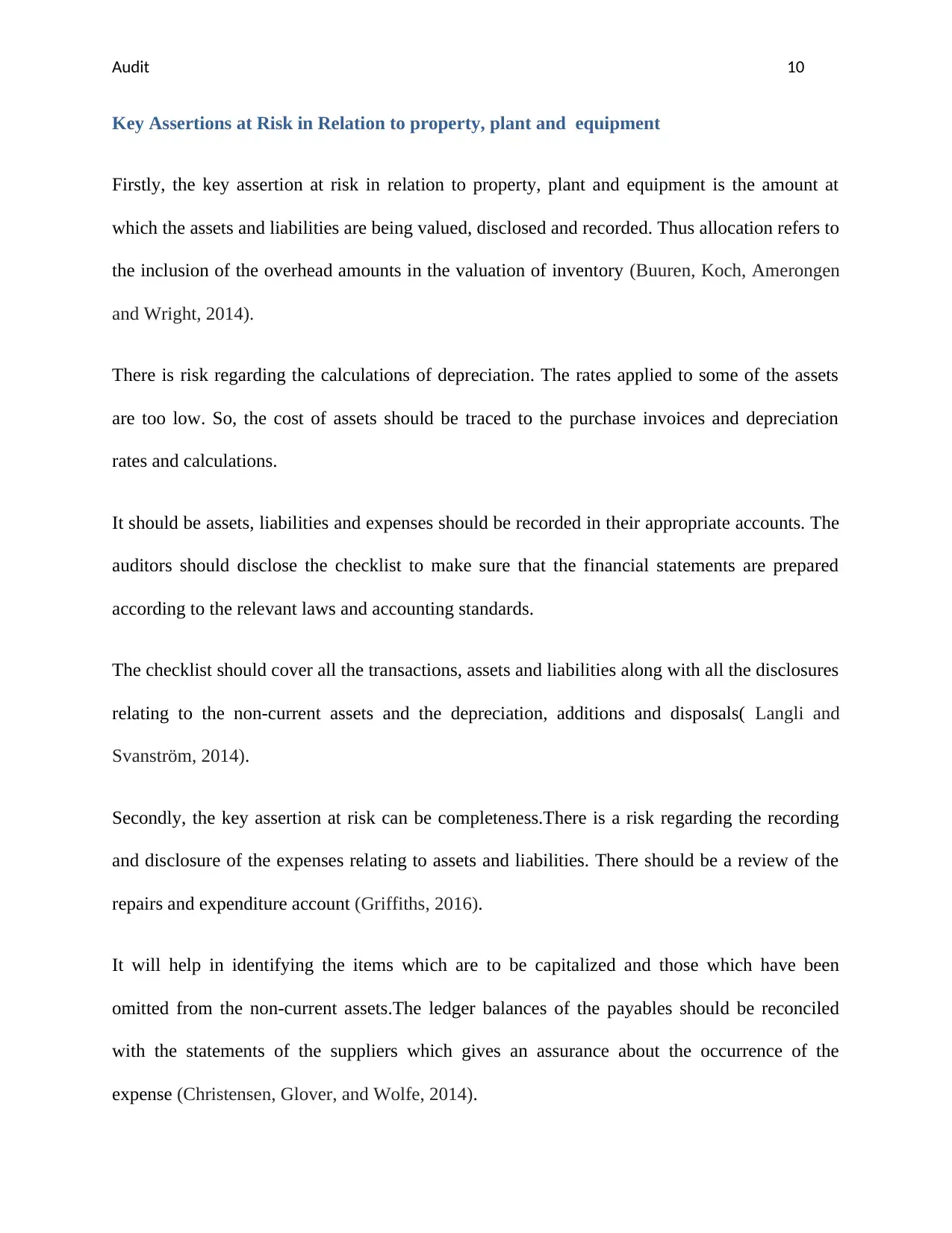
Audit 10
Key Assertions at Risk in Relation to property, plant and equipment
Firstly, the key assertion at risk in relation to property, plant and equipment is the amount at
which the assets and liabilities are being valued, disclosed and recorded. Thus allocation refers to
the inclusion of the overhead amounts in the valuation of inventory (Buuren, Koch, Amerongen
and Wright, 2014).
There is risk regarding the calculations of depreciation. The rates applied to some of the assets
are too low. So, the cost of assets should be traced to the purchase invoices and depreciation
rates and calculations.
It should be assets, liabilities and expenses should be recorded in their appropriate accounts. The
auditors should disclose the checklist to make sure that the financial statements are prepared
according to the relevant laws and accounting standards.
The checklist should cover all the transactions, assets and liabilities along with all the disclosures
relating to the non-current assets and the depreciation, additions and disposals( Langli and
Svanström, 2014).
Secondly, the key assertion at risk can be completeness.There is a risk regarding the recording
and disclosure of the expenses relating to assets and liabilities. There should be a review of the
repairs and expenditure account (Griffiths, 2016).
It will help in identifying the items which are to be capitalized and those which have been
omitted from the non-current assets.The ledger balances of the payables should be reconciled
with the statements of the suppliers which gives an assurance about the occurrence of the
expense (Christensen, Glover, and Wolfe, 2014).
Key Assertions at Risk in Relation to property, plant and equipment
Firstly, the key assertion at risk in relation to property, plant and equipment is the amount at
which the assets and liabilities are being valued, disclosed and recorded. Thus allocation refers to
the inclusion of the overhead amounts in the valuation of inventory (Buuren, Koch, Amerongen
and Wright, 2014).
There is risk regarding the calculations of depreciation. The rates applied to some of the assets
are too low. So, the cost of assets should be traced to the purchase invoices and depreciation
rates and calculations.
It should be assets, liabilities and expenses should be recorded in their appropriate accounts. The
auditors should disclose the checklist to make sure that the financial statements are prepared
according to the relevant laws and accounting standards.
The checklist should cover all the transactions, assets and liabilities along with all the disclosures
relating to the non-current assets and the depreciation, additions and disposals( Langli and
Svanström, 2014).
Secondly, the key assertion at risk can be completeness.There is a risk regarding the recording
and disclosure of the expenses relating to assets and liabilities. There should be a review of the
repairs and expenditure account (Griffiths, 2016).
It will help in identifying the items which are to be capitalized and those which have been
omitted from the non-current assets.The ledger balances of the payables should be reconciled
with the statements of the suppliers which gives an assurance about the occurrence of the
expense (Christensen, Glover, and Wolfe, 2014).
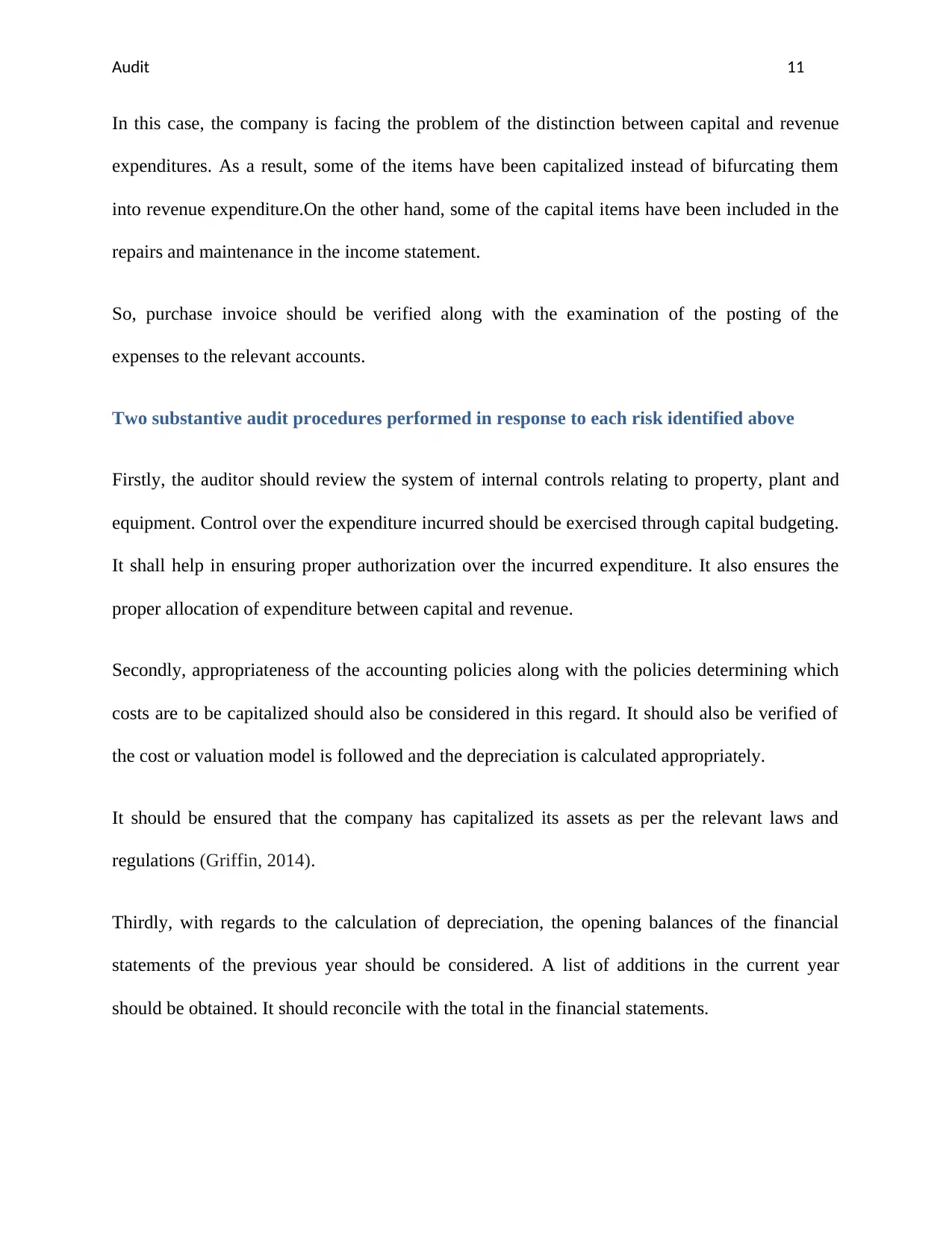
Audit 11
In this case, the company is facing the problem of the distinction between capital and revenue
expenditures. As a result, some of the items have been capitalized instead of bifurcating them
into revenue expenditure.On the other hand, some of the capital items have been included in the
repairs and maintenance in the income statement.
So, purchase invoice should be verified along with the examination of the posting of the
expenses to the relevant accounts.
Two substantive audit procedures performed in response to each risk identified above
Firstly, the auditor should review the system of internal controls relating to property, plant and
equipment. Control over the expenditure incurred should be exercised through capital budgeting.
It shall help in ensuring proper authorization over the incurred expenditure. It also ensures the
proper allocation of expenditure between capital and revenue.
Secondly, appropriateness of the accounting policies along with the policies determining which
costs are to be capitalized should also be considered in this regard. It should also be verified of
the cost or valuation model is followed and the depreciation is calculated appropriately.
It should be ensured that the company has capitalized its assets as per the relevant laws and
regulations (Griffin, 2014).
Thirdly, with regards to the calculation of depreciation, the opening balances of the financial
statements of the previous year should be considered. A list of additions in the current year
should be obtained. It should reconcile with the total in the financial statements.
In this case, the company is facing the problem of the distinction between capital and revenue
expenditures. As a result, some of the items have been capitalized instead of bifurcating them
into revenue expenditure.On the other hand, some of the capital items have been included in the
repairs and maintenance in the income statement.
So, purchase invoice should be verified along with the examination of the posting of the
expenses to the relevant accounts.
Two substantive audit procedures performed in response to each risk identified above
Firstly, the auditor should review the system of internal controls relating to property, plant and
equipment. Control over the expenditure incurred should be exercised through capital budgeting.
It shall help in ensuring proper authorization over the incurred expenditure. It also ensures the
proper allocation of expenditure between capital and revenue.
Secondly, appropriateness of the accounting policies along with the policies determining which
costs are to be capitalized should also be considered in this regard. It should also be verified of
the cost or valuation model is followed and the depreciation is calculated appropriately.
It should be ensured that the company has capitalized its assets as per the relevant laws and
regulations (Griffin, 2014).
Thirdly, with regards to the calculation of depreciation, the opening balances of the financial
statements of the previous year should be considered. A list of additions in the current year
should be obtained. It should reconcile with the total in the financial statements.
⊘ This is a preview!⊘
Do you want full access?
Subscribe today to unlock all pages.

Trusted by 1+ million students worldwide
1 out of 17
Related Documents
Your All-in-One AI-Powered Toolkit for Academic Success.
+13062052269
info@desklib.com
Available 24*7 on WhatsApp / Email
![[object Object]](/_next/static/media/star-bottom.7253800d.svg)
Unlock your academic potential
Copyright © 2020–2025 A2Z Services. All Rights Reserved. Developed and managed by ZUCOL.





